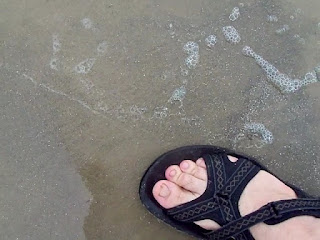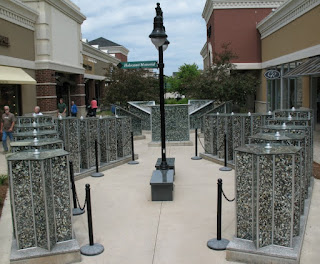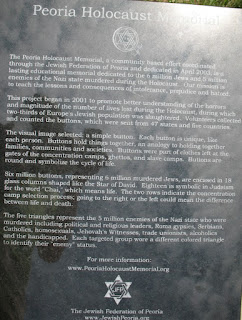Wednesday, March 28, 2012
Popping beach bubbles indirectly
Not sure of all the science behind this, but we noticed recently that if you push down with your foot near bubbles stranded on beach foam, sometimes the bubbles close to your foot will pop. The level of moisture on the sand must be just right, and it appears that pushing down on the sand dries it out under the bubbles and triggers the popping.
Monday, March 26, 2012
Convection in motor oil
Hot, old motor oil. Viewed from above, the debris in the oil upwelling in convection currents resemble mammatus clouds (from below).
Friday, March 23, 2012
Burning the candle at both ends
Burning a candle at both ends can be a demonstration of the relationship between surface area in a reaction (twice as many burning surfaces as a regularly lit candle) and kinetics (candle burns twice as fast). We refer to it as doubling the rate of oxidation of paraffinic hydrocarbon cylinders!
Thursday, March 22, 2012
Blowing up a milk jug
Don't remember where I saw this demo (perhaps the Ontario Science Center?) and have not done it myself, but the idea is to take an empty milk jug and heat one spot with a heat gun until the plastic melts but stays intact. The cloudy crystalline high density polyethylene - HDPE - turns clear during the heating. Then, blow into the jug to expand out that wall. When it cools, it will harden and turn cloudy again. This is a nice demonstration of plastic behavior and blow-molding.
Wednesday, March 21, 2012
Millions and billions
Examples of big numbers of items: a box containing a billion beads from the Houston Childrens Museum, and the Peoria Holocaust Memorial where each glass box contains a million buttons (each button represents a life lost during the WWII Holocaust).
Tuesday, March 20, 2012
Monday, March 19, 2012
Wood ash as a base
Wood ash has been used as a base for a long time. Here is a picture of an old hopper used to hold wood ash and expose it to rain water. As the water percolates through the ash, metal oxides are converted to soluble hydroxide salts, which come out the bottom of the funnel and are collected. This base could be used, for example, to help convert fats into soap.
Sunday, March 18, 2012
First post and metric images

 This blog is an experiment to post various demos and related activities with which I have been involved over the years. It should be searchable using the engine in the upper left corner. I also have a repository of some demos on the web at Bradley University(http://bradley.bradley.edu/~campbell/demos1.html), the University of Wisconsin-Madison (http://mrsec.wisc.edu/Edetc/LEGO/index.html), and the University of Texas at Austin (http://www.nano.utexas.edu/resources/nano-at-home/). Here are some images related to the metric system: a speed conversion sign near the US/Canadian border, a temperature conversion sign near the US/Canadian border, and a picture of a sign at the intersection of Metric Boulevard and Centimeter Circle in Austin, TX.
This blog is an experiment to post various demos and related activities with which I have been involved over the years. It should be searchable using the engine in the upper left corner. I also have a repository of some demos on the web at Bradley University(http://bradley.bradley.edu/~campbell/demos1.html), the University of Wisconsin-Madison (http://mrsec.wisc.edu/Edetc/LEGO/index.html), and the University of Texas at Austin (http://www.nano.utexas.edu/resources/nano-at-home/). Here are some images related to the metric system: a speed conversion sign near the US/Canadian border, a temperature conversion sign near the US/Canadian border, and a picture of a sign at the intersection of Metric Boulevard and Centimeter Circle in Austin, TX.
Subscribe to:
Posts (Atom)













